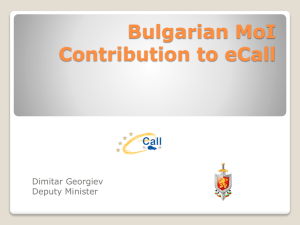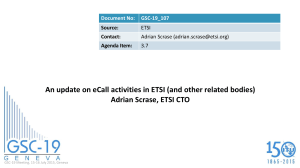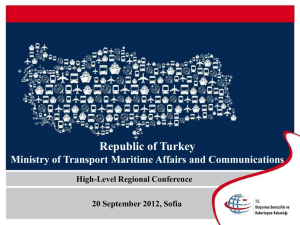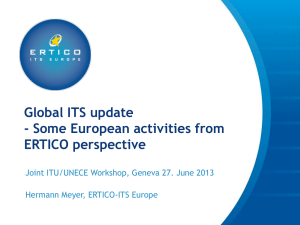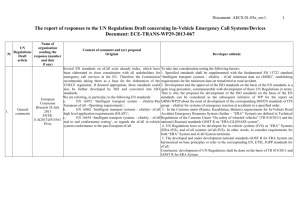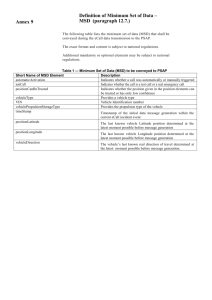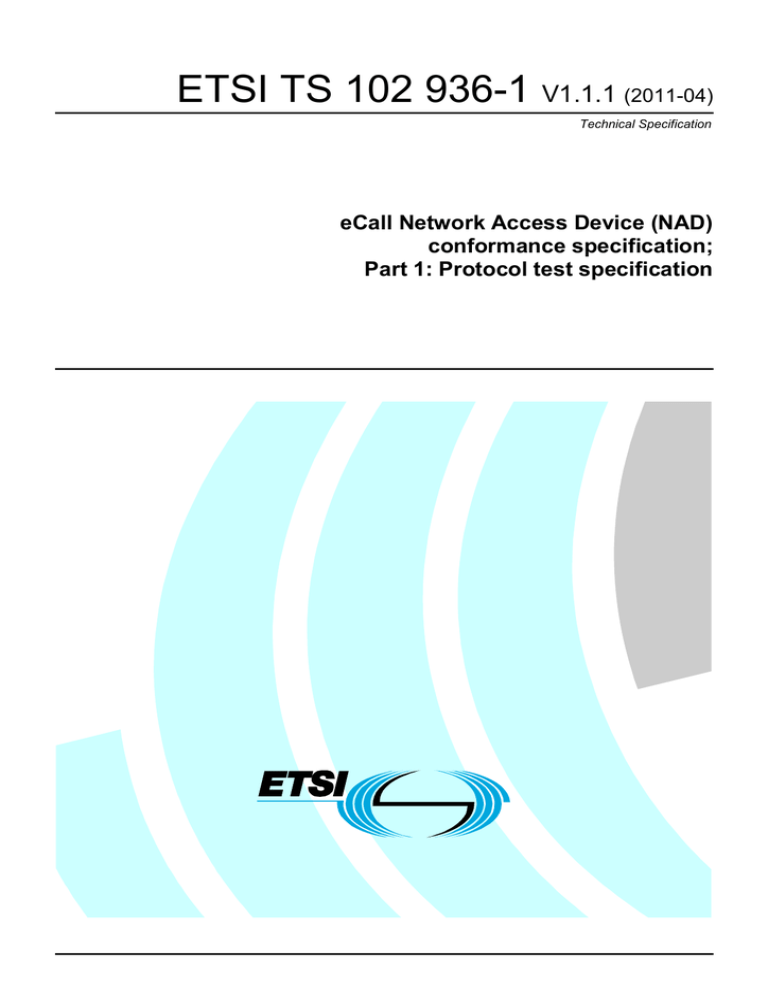
ETSI TS 102 936-1 V1.1.1 (2011-04)
Technical Specification
eCall Network Access Device (NAD)
conformance specification;
Part 1: Protocol test specification
2
ETSI TS 102 936-1 V1.1.1 (2011-04)
Reference
DTS/MSG-00eCall01-1
Keywords
cellular, conformance, ecall, emergency, GSM,
mobile, testing, UMTS
ETSI
650 Route des Lucioles
F-06921 Sophia Antipolis Cedex - FRANCE
Tel.: +33 4 92 94 42 00 Fax: +33 4 93 65 47 16
Siret N° 348 623 562 00017 - NAF 742 C
Association à but non lucratif enregistrée à la
Sous-Préfecture de Grasse (06) N° 7803/88
Important notice
Individual copies of the present document can be downloaded from:
http://www.etsi.org
The present document may be made available in more than one electronic version or in print. In any case of existing or
perceived difference in contents between such versions, the reference version is the Portable Document Format (PDF).
In case of dispute, the reference shall be the printing on ETSI printers of the PDF version kept on a specific network drive
within ETSI Secretariat.
Users of the present document should be aware that the document may be subject to revision or change of status.
Information on the current status of this and other ETSI documents is available at
http://portal.etsi.org/tb/status/status.asp
If you find errors in the present document, please send your comment to one of the following services:
http://portal.etsi.org/chaircor/ETSI_support.asp
Copyright Notification
No part may be reproduced except as authorized by written permission.
The copyright and the foregoing restriction extend to reproduction in all media.
© European Telecommunications Standards Institute 2011.
All rights reserved.
TM
TM
TM
TM
DECT , PLUGTESTS , UMTS , TIPHON , the TIPHON logo and the ETSI logo are Trade Marks of ETSI registered
for the benefit of its Members.
TM
3GPP is a Trade Mark of ETSI registered for the benefit of its Members and of the 3GPP Organizational Partners.
LTE™ is a Trade Mark of ETSI currently being registered
for the benefit of its Members and of the 3GPP Organizational Partners.
GSM® and the GSM logo are Trade Marks registered and owned by the GSM Association.
ETSI
3
ETSI TS 102 936-1 V1.1.1 (2011-04)
Contents
Intellectual Property Rights ................................................................................................................................4
Foreword.............................................................................................................................................................4
Introduction ........................................................................................................................................................4
1
Scope ........................................................................................................................................................6
2
References ................................................................................................................................................6
2.1
2.2
3
3.1
3.2
4
4.1
4.2
4.3
5
5.1
5.1.1
5.1.1.1
5.1.1.2
5.1.1.3
5.1.1.4
5.1.1.5
5.1.1.6
5.1.1.7
5.2
6
6.1
6.1.1
6.1.1.1
6.1.1.2
6.1.1.3
6.1.1.4
6.1.1.5
6.1.1.6
6.1.1.7
6.2
Normative references ......................................................................................................................................... 6
Informative references ........................................................................................................................................ 7
Definitions and abbreviations ...................................................................................................................7
Definitions .......................................................................................................................................................... 7
Abbreviations ..................................................................................................................................................... 7
General aspects of eCall conformance testing..........................................................................................7
Types of eCall capable UE - Unrestricted and Restricted .................................................................................. 8
Establishment of eCalls by the UE under test .................................................................................................... 8
Establishment of eCall test and reconfiguration calls ......................................................................................... 8
UMTS network access eCall NAD conformance tests.............................................................................8
eCall Emergency Call Procedures ...................................................................................................................... 8
eCall with USIM ........................................................................................................................................... 8
Void......................................................................................................................................................... 9
Test call using eCall capable UE with 'eCall only' subscription on USIM ............................................. 9
Manually initiated eCall using eCall capable UE with 'eCall only' subscription on USIM .................... 9
Reconfiguration call using eCall capable UE with 'eCall only' subscription .......................................... 9
Manually initiated eCall using eCall capable UE with eCall and non eCall subscription on USIM ....... 9
eCall Inactivity State after T3242 expires ............................................................................................... 9
Automatically initiated eCall .................................................................................................................. 9
Applicability of eCall NAD tests for UMTS network access ............................................................................. 9
GSM network access eCall NAD conformance tests ...............................................................................9
eCall Emergency Call Procedures .................................................................................................................... 10
eCall with USIM ......................................................................................................................................... 10
Void....................................................................................................................................................... 10
Test call using eCall capable MS with 'eCall only' subscription on USIM ........................................... 10
Manually initiated eCall using eCall capable MS with 'eCall only' subscription on USIM .................. 10
Manually initiated eCall using eCall capable MS with eCall capable USIM ........................................ 10
eCall Inactivity State after T3242 expires ............................................................................................. 10
Automatically initiated eCall ................................................................................................................ 10
Reconfiguration call using eCall capable MS with 'eCall only' subscription ........................................ 10
Applicability of eCall NAD tests for GSM network access ............................................................................. 10
Annex A (informative):
Bibliography ...................................................................................................11
History ..............................................................................................................................................................12
ETSI
4
ETSI TS 102 936-1 V1.1.1 (2011-04)
Intellectual Property Rights
IPRs essential or potentially essential to the present document may have been declared to ETSI. The information
pertaining to these essential IPRs, if any, is publicly available for ETSI members and non-members, and can be found
in ETSI SR 000 314: "Intellectual Property Rights (IPRs); Essential, or potentially Essential, IPRs notified to ETSI in
respect of ETSI standards", which is available from the ETSI Secretariat. Latest updates are available on the ETSI Web
server (http://webapp.etsi.org/IPR/home.asp).
Pursuant to the ETSI IPR Policy, no investigation, including IPR searches, has been carried out by ETSI. No guarantee
can be given as to the existence of other IPRs not referenced in ETSI SR 000 314 (or the updates on the ETSI Web
server) which are, or may be, or may become, essential to the present document.
Foreword
This Technical Specification (TS) has been produced by ETSI Technical Committee Mobile Standards Group (MSG).
The present document is part 1 of a multi-part deliverable covering eCall Network Access Device (NAD) conformance
specification as identified below:
Part 1:
"Protocol test specification";
Part 2:
"Test suites".
The present document may refer to technical specifications or reports using their 3GPP identities, UMTS identities or
GSM identities. These should be interpreted as being references to the corresponding ETSI deliverables.
The cross reference between GSM, UMTS, 3GPP and ETSI identities can be found under
http://webapp.etsi.org/key/queryform.asp.
Introduction
Following a decision of the European Parliament, and a request by the European Commission to ETSI, ETSI TC MSG
was tasked with managing the technical specification and creation of open standards for the Pan-European eCall
emergency service.
An eCall is an emergency voice call, initiated manually or automatically from a vehicle to a Public Safety Answering
Point (PSAP), supplemented by up to 140 bytes of incident related data. The Minimum Set of Data (MSD) has been
defined by CEN Technical Committee 278 and includes the GNSS derived location and direction of travel of the
vehicle, the Vehicle Identification Number (VIN) and other information to enable the emergency response teams to
quickly locate and provide medical and other life saving assistance to the accident victims.
eCall has been designed to operate over any PLMN that supports emergency voice calls, specifically TeleService 12.
Should the MSD not be transmitted or received for any reason, or if the PSAP is not equipped with the necessary eCall
equipment (eCall modem / server), the accident victims and PSAP operator may still converse using the In-Vehicle
System (IVS) audio equipment.
The 3rd Generation Partnership Project (3GPP) has specified the eCall service requirements, data transmission protocols
and network signaling aspects for Release 8. The in-band modem used to transfer the MSD from the vehicle to the
PSAP, following the establishment of a TS12 emergency voice call, has been specified by 3GPP TSG SA WG 4.
Once an eCall is invoked, initiated manually by the vehicle occupants or automatically as the result of an accident, the
eCall call set-up and clear-down procedures (RR, CC, and MM) are automatically controlled by the eCall in-vehicle
system (IVS) and its associated network access device (NAD). Once initiated the system requires no MMI intervention
and does not permit the user to intervene at any stage during call management. It is important, therefore, that the eCall
system works autonomously and reliably when faced with a wide range of probable network access events.
ETSI
5
ETSI TS 102 936-1 V1.1.1 (2011-04)
The present document specifies the eCall applicable tests required to ensure eCall NAD conformance when accessing
Digital cellular telecommunications system (Phase 2+) and Universal Mobile Telecommunications System (UMTS)
mobile networks. The present document includes references to existing ETSI technical specifications including
TS 151 010-1 [6] and TS 134 123-1 [3] that contain the necessary detailed eCall and generic UE conformance tests.
The eCall in-band modem conformance test protocols are as specified in TS 126 269 [2].
A guide to the applicability of ETSI GSM and UMTS mobile station harmonised standards EN 301 908 parts 1 [8] and
2 [9] and EN 301 511 [10] to the ETSI specified eCall NAD, for the purpose of demonstrating compliance with R&TTE
Directive 1999/5/EC [i.2] article 3.2, can be found in TR 102 937 [i.1].
ETSI
6
1
ETSI TS 102 936-1 V1.1.1 (2011-04)
Scope
The present document specifies the eCall applicable tests required to ensure eCall NAD conformance when accessing
Digital cellular telecommunications system (Phase 2+) and Universal Telecommunication System (UMTS) mobile
networks. The present document includes references to existing ETSI technical specifications including
TS 151 010-1 [6] and TS 134 123-1 [3] that contain the necessary detailed eCall and generic UE conformance tests.
2
References
References are either specific (identified by date of publication and/or edition number or version number) or
non-specific. For specific references, only the cited version applies. For non-specific references, the latest version of the
referenced document (including any amendments) applies.
Referenced documents which are not found to be publicly available in the expected location might be found at
http://docbox.etsi.org/Reference.
NOTE:
2.1
While any hyperlinks included in this clause were valid at the time of publication ETSI cannot guarantee
their long term validity.
Normative references
The following referenced documents are necessary for the application of the present document.
[1]
ETSI TS 122 101: "Universal Mobile Telecommunications System (UMTS); LTE; Service
aspects; Service principles (3GPP TS 22.101)".
[2]
ETSI TS 126 269: "Digital cellular telecommunications system (Phase 2+); Universal Mobile
Telecommunications System (UMTS); eCall data transfer; In-band modem solution; Conformance
testing (3GPP TS 26.269)".
[3]
ETSI TS 134 123-1: "Universal Mobile Telecommunications System (UMTS); User Equipment
(UE) conformance specification; Part 1: Protocol conformance specification (3GPP TS 34.123-1)".
[4]
ETSI TS 134 123-2: "Universal Mobile Telecommunications System (UMTS); User Equipment
(UE) conformance specification; Part 2: Implementation conformance statement (ICS) proforma
specification (3GPP TS 34.123-2)".
[5]
ETSI TS 134 123-3: "Universal Mobile Telecommunications System (UMTS); User Equipment
(UE) conformance specification; Part 3: Abstract Test Suites (ATSs) (3GPP TS 34.123-3)".
[6]
ETSI TS 151 010-1: "Digital cellular telecommunications system (Phase 2+); Mobile Station (MS)
conformance specification; Part 1: Conformance specification (3GPP TS 51.010-1)".
[7]
ETSI TS 151 010-2: "Digital cellular telecommunications system (Phase 2+); Mobile Station (MS)
conformance specification; Part 2: Protocol Implementation Conformance Statement (PICS)
proforma specification (3GPP TS 51.010-2)".
[8]
ETSI EN 301 908-1: "IMT cellular networks; Harmonized EN covering the essential requirements
of article 3.2 of the R&TTE Directive; Part 1: Introduction and common requirements".
[9]
ETSI EN 301 908-2: "IMT cellular networks; Harmonized EN covering the essential requirements
of article 3.2 of the R&TTE Directive; Part 2: CDMA Direct Spread (UTRA FDD) User
Equipment (UE)".
[10]
ETSI EN 301 511: "Global System for Mobile communications (GSM); Harmonized EN for
mobile stations in the GSM 900 and GSM 1800 bands covering essential requirements under
article 3.2 of the R&TTE directive (1999/5/EC)".
ETSI
7
2.2
ETSI TS 102 936-1 V1.1.1 (2011-04)
Informative references
The following referenced documents are not necessary for the application of the present document but they assist the
user with regard to a particular subject area.
[i.1]
ETSI TR 102 937: "Mobile systems; Guidelines on applicability of GSM and UMTS mobile
station harmonized standards to eCall Network Access Device (NAD)".
[i.2]
Directive 1999/5/EC of the European Parliament and of the Council of 9 March 1999 on radio
equipment and telecommunications terminal equipment and the mutual recognition of their
conformity (R&TTE Directive).
3
Definitions and abbreviations
3.1
Definitions
For the purposes of the present document, the following terms and definitions apply:
eCall: manually or automatically initiated emergency call, (TS12) from a vehicle, supplemented with a minimum set of
emergency related data (MSD), as defined under the EU Commission's eSafety initiative
Minimum Set of Data (MSD): data component of an eCall sent from a vehicle to a Public Safety Answering Point or
other designated emergency call centre
NOTE:
3.2
The MSD has a maximum size of 140 bytes and includes, for example, vehicle identity, location
information and time-stamp.
Abbreviations
For the purposes of the present document, the following abbreviations apply:
AIeC
CC
CEN
EFFDN
EFSDN
GNSS
ICS
IVS
MIeC
MM
MSD
NAD
PLMN
PSAP
RR
UMTS
USIM
VIN
4
Automatically Initiated eCall
Call Control
Commission Européen de Normalisation
Elementary File Fixed Dialling Numbers
Elementary File Service Dialling Numbers
Global Navigation Satellite System
Implementation Conformance Statement
In Vehicle System (eCall terminal and associated sub-systems in vehicle)
Manually Initiated eCall
Mobility Management
Minimum Set of Data
Network Access Device
Public Land Mobile Network
Public Safety Answering Point
Radio Resource
Universal Mobile Telecommunications System
UMTS Subscriber Identification Module
Vehicle Identification Number
General aspects of eCall conformance testing
The eCall service is based on the pan-European harmonised 112 emergency service supplemented by accident related
data. An eCall is initiated automatically when a collision of sufficient severity occurs, or manually by the vehicle
occupants. Once initiated the eCall proceeds automatically without the need for any user intervention. As a life saving
emergency service the correct operation and reliability of the autonomous eCall system needs to be ensured through
conformance testing.
ETSI
8
4.1
ETSI TS 102 936-1 V1.1.1 (2011-04)
Types of eCall capable UE - Unrestricted and Restricted
In order to avoid the generation of large volumes of unnecessary mobility management (MM) signaling, when not
engaged in an eCall, test or reconfiguration call, additional network access restrictions apply to certain 'eCall only'
devices in accordance with TS 122 101 [1].
eCall capable UEs are divided into two types, unrestricted and restricted. Unrestricted eCall UEs are those that have the
capability and are configured to also access other non-emergency subscription services. Restricted eCall UEs are those
that either do not support the capability to access other non-emergency services, or are normally unrestricted eCall UEs
that have been configured to make only eCalls. In the latter case the restricted eCall capable UE is referred to as an
'eCall only' UE.
All eCall capable UEs may make calls to a network operator designated non-emergency numbers for the purpose of
making test eCalls, and to request reconfiguration of the UE allowing access to commercial services.
4.2
Establishment of eCalls by the UE under test
A Manually Initiated eCall (MIeC) or an Automatically Initiated eCall (AIeC) shall be initiated in accordance with the
information provided by the manufacturer in the Implementation Conformance Statement (ICS) proforma [4].
The eCall capable UE is expected to provide a call set-up MMI that enables the user to manually establish an eCall e.g.
an SOS button. Additionally, an eCall capable UE is expected to support an interface that allows an associated eCall invehicle system (IVS) to automatically initiate an eCall. The emergency call set-up message sent to the network includes,
in the Service Category information element, an indication that the present call is either a Manually Initiated eCall
(MIeC) or an Automatically Initiated eCall (AIeC).
4.3
Establishment of eCall test and reconfiguration calls
An eCall test or reconfiguration call shall be initiated in accordance with the information provided by the manufacturer
in the Implementation Conformance Statement (ICS) proforma [4].
The purpose of the eCall test and reconfiguration calls is to ensure that the UE under test, when configured for 'eCall
only', is capable of establishing a call to each of the non-emergency fixed dialling numbers stored on the USIM in
EFFDN . It is also verified that, following call clear-down, an 'eCall only' UE deregisters from the network and returns to
the MM IDLE eCall INACTIVE state when timer T3242 or T3243 expires.
The eCall capable UE provides a call set-up MMI that enables test and reconfiguration calls to be established using the
dialled numbers stored on the USIM in EFFDN or, in the case of an unrestricted eCall capable UE, in EFSDN
5
UMTS network access eCall NAD conformance tests
The terminal type and eCall applicable tests required to ensure eCall NAD conformance when accessing a Universal
Telecommunication System (UMTS) mobile network are specified, by reference, in the following clauses. eCall NAD
conformance testing shall be carried out in accordance with the tests and test procedures specified in TS 134 123
Part 1 [3], Part 2 [4] and Part 3 [5].
5.1
eCall Emergency Call Procedures
Reference TS 134 123-1 [3], clause 13.3.
5.1.1
eCall with USIM
Reference TS 134 123-1 [3], clause 13.3.1.
ETSI
9
ETSI TS 102 936-1 V1.1.1 (2011-04)
5.1.1.1
Void
5.1.1.2
Test call using eCall capable UE with 'eCall only' subscription on USIM
Reference TS 134 123-1 [3], clause 13.3.1.2.
5.1.1.3
Manually initiated eCall using eCall capable UE with 'eCall only' subscription
on USIM
Reference TS 134 123-1 [3], clause 13.3.1.3.
5.1.1.4
Reconfiguration call using eCall capable UE with 'eCall only' subscription
Reference TS 134 123-1 [3], clause 13.3.1.4.
5.1.1.5
Manually initiated eCall using eCall capable UE with eCall and non eCall
subscription on USIM
Reference TS 134 123-1 [3], clause 13.3.1.5.
5.1.1.6
eCall Inactivity State after T3242 expires
Reference TS 134 123-1 [3], clause 13.3.1.6.
5.1.1.7
Automatically initiated eCall
Reference TS 134 123-1 [3], clause 13.3.1.7.
5.2
Applicability of eCall NAD tests for UMTS network access
Table 5.1: Applicability of tests (TS 134 123-2 [4])
Clause
13.3
13.3.1
13.3.1.2
13.3.1.3
13.3.1.4
Title
eCall Emergency Call Procedures
eCall with USIM
Test call using eCall capable UE with 'eCall
only' subscription on USIM
Manually initiated eCall using eCall capable UE
with 'eCall only' subscription on USIM
Reconfiguration call using eCall capable UE
with 'eCall only' subscription on USIM
Release
Rel-8
Rel-8
Rel-8
Comments
UEs supporting 'eCall only' subscription
and capable of triggering a test eCall
UEs supporting 'eCall only' subscription
and capable of initiating manual eCall
UEs supporting 'eCall only' subscription
and capable of triggering a reconfiguration
call
UEs supporting emergency speech call
and eCall subscription and capable of
initiating manual eCall
UEs supporting eCall only subscription
and capable of initiating manual eCall
UEs supporting emergency speech and
'eCall only' subscription and capable of
initiating automatic eCall
13.3.1.5
Manually initiated eCall using eCall capable UE Rel-8
with eCall and non eCall subscriptions on USIM
13.3.1.6
eCall Inactivity State after T3242 expires
Rel-8
13.3.1.7
Automatically initiated eCall
Rel-8
6
GSM network access eCall NAD conformance tests
The terminal type and eCall applicable tests required to ensure eCall NAD conformance when accessing a Digital
cellular telecommunications system (Phase 2+) mobile network are specified, by reference, in the following clauses.
eCall NAD conformance testing shall be carried out in accordance with the tests and test procedures specified in
TS 151 010 Parts 1 [6] and 2 [7].
ETSI
10
6.1
ETSI TS 102 936-1 V1.1.1 (2011-04)
eCall Emergency Call Procedures
Reference TS 151 010-1 [6], clause 26.9.6a.
6.1.1
eCall with USIM
Reference TS 151 010-1 [6], clause 26.9.6a.1.
6.1.1.1
Void
6.1.1.2
Test call using eCall capable MS with 'eCall only' subscription on USIM
Reference TS 151 010-1 [6], clause 26.9.6a.1.2.
6.1.1.3
Manually initiated eCall using eCall capable MS with 'eCall only' subscription
on USIM
Reference TS 151 010-1 [6], clause 26.9.6a.1.3.
6.1.1.4
Manually initiated eCall using eCall capable MS with eCall capable USIM
Reference TS 151 010-1 [6], clause 26.9.6a.1.4.
6.1.1.5
eCall Inactivity State after T3242 expires
Reference TS 151 010-1 [6], clause 26.9.6a.1.5.
6.1.1.6
Automatically initiated eCall
Reference TS 151 010-1 [6], clause 26.9.6a.1.6.
6.1.1.7
Reconfiguration call using eCall capable MS with 'eCall only' subscription
Reference TS 151 010-1 [6], clause 26.9.6a.1.7.
6.2
Applicability of eCall NAD tests for GSM network access
Table 6.1: Applicability of tests (TS 151 010-2 [7])
Clause
26.9.6a
26.9.6a.1
26.9.6a.1.2
26.9.6a.1.3
26.9.6a.1.4
Title
Structured Calls / eCall
eCall with USIM
Test call using eCall capable MS with 'eCall
only' subscription on USIM
Manually initiated eCall using eCall capable
MS with 'eCall only' subscription on USIM
Manually initiated eCall using eCall capable
MS with eCall capable USIM
Release
Rel-8
Rel-8
Rel-8
26.9.6a.1.5
eCall Inactivity State after T3242 expires
Rel-8
26.9.6a.1.6
Automatically initiated eCall
Rel-8
26.9.6a.1.7
Reconfiguration call using eCall capable MS
with 'eCall only' subscription on USIM
Rel-8
ETSI
Comments
MS supporting 'eCall only' subscription
and capable of triggering a test eCall
MS supporting 'eCall only' subscription
and capable of initiating manual eCall
MS supporting emergency speech call and
eCall subscription and capable of initiating
manual eCall
MS supporting 'eCall only' subscription
and capable of initiating manual eCall
MS supporting emergency speech and
'eCall only' subscription and capable of
initiating automatic eCall
MS supporting 'eCall only' subscription
and capable of triggering a reconfiguration
call
11
ETSI TS 102 936-1 V1.1.1 (2011-04)
Annex A (informative):
Bibliography
ETSI TS 124 008: "Digital cellular telecommunications system (Phase 2+); Universal Mobile Telecommunications
System (UMTS); LTE; Mobile radio interface Layer 3 specification; Core network protocols; Stage 3
(3GPP TS 24.008)".
ETSI TS 127 007: "Digital cellular telecommunications system (Phase 2+); Universal Mobile Telecommunications
System (UMTS); LTE; AT command set for User Equipment (UE) (3GPP TS 27.007)".
ETSI TS 131 102: "Universal Mobile Telecommunications System (UMTS); LTE; Characteristics of the Universal
Subscriber Identity Module (USIM) application (3GPP TS 31.102)".
ETSI TS 134 108: "Universal Mobile Telecommunications System (UMTS); LTE; Common test environments for User
Equipment (UE); Conformance testing (3GPP TS 34.108)".
ETSI TS 134 109: "Universal Mobile Telecommunications System (UMTS); LTE; Terminal logical test interface;
Special conformance testing functions (3GPP TS 34.109)".
ETSI TS 102 936-2: "Mobile systems; eCall Network Access Device (NAD) conformance specification Part 2: Test
suites".
ETSI
12
History
Document history
V1.1.1
April 2011
Publication
ETSI
ETSI TS 102 936-1 V1.1.1 (2011-04)

